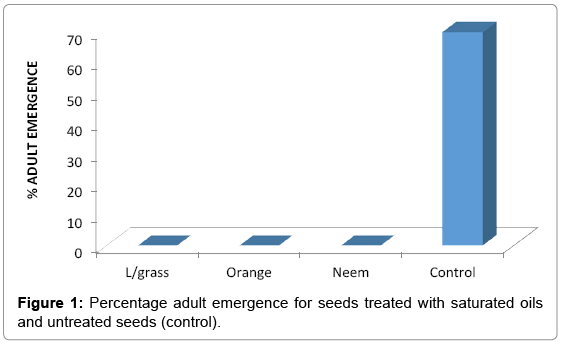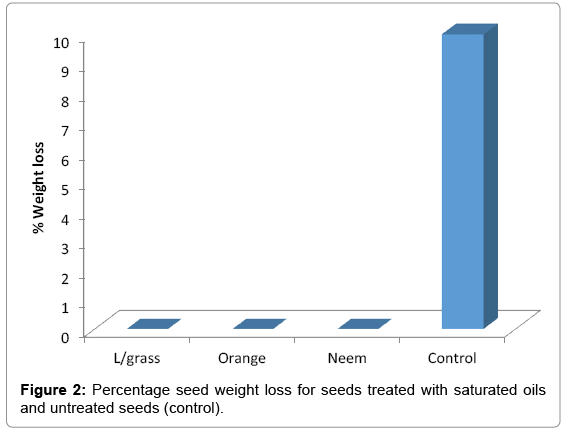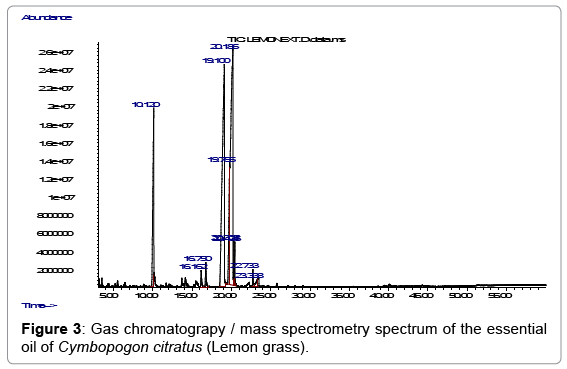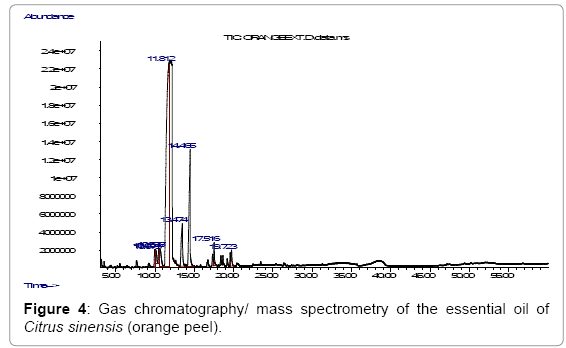Research Article Open Access
Efficacy of Some Plant Extracts as Storage Protectants against Callosobruchus maculatus
Mojisola Esther Ojebode1*, Charles Openiyi Olaiya1, Adegoke Emmanuel Adegbite2, Kayode Olayele Karigidi1and Tosin Oluwaseun Ale31Nutritional and Industrial Biochemistry Research Laboratories, University of Ibadan, Nigeria
2Department of Biological Sciences, Ondo State University of Science and Technology, Okitipupa, Ondo State, Nigeria
3Pharmaceutical Chemistry Research Laboratories, University of Ibadan, Nigeria
- Corresponding Author:
- Mojisola Esther Ojebode
Nutritional and Industrial Biochemistry Research Laboratories
University of Ibadan, Nigeria
Tel: 2347069703104
E-mail: mojisolaojebode@yahoo.com
Received date: November 19, 2015; Accepted date: January 21, 2016; Published date: February 01, 2016
Citation:Ojebode ME, Olaiya CO, Adegbite AE, Karigidi KO, Ale TO (2016) Efficacy of Some Plant Extracts as Storage Protectants against Callosobruchus maculatus. J Biotechnol Biomater 6:217. doi:10.4172/2155-952X.1000217
Copyright: © 2016 Ojebode ME, et al. This is an open-access article distributed under the terms of the Creative Commons Attribution License, which permits unrestricted use, distribution, and reproduction in any medium, provided the original author and source are credited
Visit for more related articles at Journal of Biotechnology & Biomaterials
Abstract
A significant quantity of crops is lost as a result of application of non-selective crop protection agents. The agrochemical industry is faced with increasing demand for the development of new crop protection agents that are safe for the environment and consumers. This research aimed at contributing to the collation and organization of baseline data on natural insect repelling and insecticidal agents. It also aimed at discovering crop protection agents that would preferentially get rid of pests. The need to develop pest control measures as alternative to chemicals is a priority for Scientists worldwide. Therefore, it is critical to find a cost effective and non-toxic method to prevent pest attack on field or stored crops. In this study, Cymbopogon citratus (lemon grass), Citrus sinensis (orange peel) and Azadirachta indica (neem) were used to investigate and evaluate the potency of the fixed and essential oils of these plants as pest control agent for the main storage insect pest of cowpea- Callosobruchus maculatus. All extracts were toxic to adult C. maculatus and prevented egg hatching. However, Citrus sinensis showed the highest weevil mortality on the first day of exposure, followed by Azadirachta indica and the least toxic was Cymbopogon citratus in the fixed oil category of extracts while in the essential oil category, Cymbopogon citratus showed 100% adult weevil mortality within one hour of exposure and Citrus sinensis was able to achieve 100% weevil mortality at the third hour of exposure. The Gas Chromatography/Mass Spectrometry (GC/MS) analysis of the essential oils of Cymbopogon citratus and Citrus sinensis was used to identify possible components of the oils comparing with existing data. This led to the development of technique adoptable for small holder farmers and cowpea traders.
Keywords
Azadirachta indica; Callosobruchus maculatus; Citrus sinensis; Cowpea; Cymbopogon citratus; Protectants; Insect pest
Introduction
The increasing public concerns on food safety and environmental health combined with the emergence of resistanceof insect pests to pesticides have become a major challenge to scientists and the agrochemical industries worldwide [1,2]. Insect pests cause heavy post-harvest losses to stored grain globally but the problem is more devastating in developing countries [3]. Increasing challenges associated with the use of synthetic chemicals for the control of stored grain products necessitates the search for safe biological agent that can be used as insecticide for stored food products [4]. Hence, the need to discover and develop botanical materials as crop protection agents that will be environment- friendly and of no harm to non-target organisms. Use of plant products as insecticide is one of the important approaches to the management of stored grain pests and it has shown many benefits over the use of synthetic chemicals [5].
Cowpea (Vigna unguiculata L. Walp) is a food and animal feed crop grown in the semi-arid tropics covering Africa, Asia, Europe, United States and Central and South America. The high protein content (25%) of cowpea with vitamins and minerals makes it an important economic crop in sub Saharan region like Nigeria. Cowpea is the most important food crop after cereal crops [6], and most affordable source of plant protein especially to people with low income in many tropical countries in Africa and Asia where it is predominantly eaten [7]. Its adaptability to different types of soil, intercropping systems, and resistance to drought, ability to improve soil fertility and prevent erosion makes it an important economic crop in many developing regions.
Cowpea weevils (Callosobruchus maculatus F.) is the major storage insect pest of legumes and peas especially cowpea [8]. C. maculatus is very destructive on account of its short life cycle. This insect pest infests cowpea in storage, thereby reducing the quality and quantity of the seeds [9]. A number of plant substances have been considered for use as insect repellents and anti-feedants. Azadirachta indica, also known as Neem, is a tree in the mahogany family Meliaceae. It is native to India and the Indian subcontinent including Pakistan, and Sri Lanka. It is typically grown in tropical and semi-tropicalregions.
Previously, essential oil derived from orange peels has been shown to be toxic on grain borer, Rhyzoperta domonica F, rice weevil, Sitophilus oryzae (L) and red flour bee [10]. Also, extracts of Azadirachta indica have been reported to pose insecticidal activity against Tribolium castaneum [11]. Cymbopogon citratus essential oil has also been reported to be toxic on Musca domestica larval and newly-hatched larvae to adult [12], as well as maize weevil Sitophilus zeamais [13].
The objective of this research was to evaluate the efficacy of three plants shown in Table 1: Cymbopogon citratus (Lemon grass), Citrus sinensis (Orange peel) and Azadirachta indica (Neem) using the fixed oil and essential oil extracted from these plants as insecticidal agents against Callosobruchus maculatus.
| Scientific name | Family | Part used | Common name |
|---|---|---|---|
| Cymbopogoncitratus | Gramineae | Leaves | Lemon grass |
| Citrus sinensis | Rutaceae | Peel | Sweet orange |
| Azadirachtaindica | Meliaceae | Leaves | Neem |
Table 1: Plant samples evaluated for insecticidal activities against C. maculatu.
Materials and Methods
Insect rearing
Uninfested cowpea seeds (Vigna unguiculata L. Walp) were obtained from a store in Bodija market, Bodija, South West Nigeria. Insect rearing and experiments were conducted in the Plant Biochemistry section of the Nutritional and Industrial Biochemistry Research Laboratories of the Department of Biochemistry, University of Ibadan. The seeds were covered in an air-tight polythene bag for eight weeks for emergence of adult cowpea weevils (Callosobruchus maculatus F.). The adult weevils were transferred into slightly pierced clean and unused transparent containers with a layer of cowpea seeds 20 g each. Five pairs of insects were introduced into each container at room temperature from which adults were reared subsequently by replacing devoured and infested seeds with fresh and uninfested seeds.
Plant materials
Lemon grass was planted and harvested from the screen house and Neem leaves were obtained from the surroundings of the University of Ibadan while the orange peels were obtained from Bodija market. The orange samples were peeled for use when needed as fresh samples.
Clean seed preparation
Whole seeds free of puncture and eggs were selected and refrigerated for 96 hours at 4ºC to ensure the death of any unseen egg. The seeds were allowed to dry for an hour and weighed prior to treatment with plants extracts.
Preparation of plant extracts
Lemon grass, Neem and Orange peel were cut into small pieces, air dried for 21-28 days and pulverised into fine powder using electric grinder. 285 g of the milled samples of C. citratus, A. indica and C. sinensis were soaked in 1200 mL, 900 mL, 750 mL analytical grade n-hexane (Sigma, St. Louis MO) respectively on magnetic stirrer. After 72 hr, the extracts were filtered using muslin cloth and filter paper. The filtrates were concentrated using rotary evaporator, further elimination of solvent was done by drying in an oven at 4ºC and 600 mmHg. The crude extracts also known as fixed oil obtained weighed 2.469 g, 2.796 g and 3.195 g fixed oil of lemon grass, neem and orange peel respectively.
Preparation of essential oils
For the essential oils of lemon grass and orange peel, fresh samples were used. These were subjected to hydrodistillation in a Clevenger apparatus for about 3 hours. The mixture of oil and distilled water was separated using a separating funnel.
Contact toxicity of fixed oils against C. maculatus
Clean cowpea seeds weighing 10 g were treated with 0.1 g, 0.2 g and 0.3 g of fixed oil extracts (1%, 2%, 3% w/w) in triplicate without carrier solvent. Proper mixing was done to ensure that the seeds were uniformly treated. Three pairs of adult weevils were introduced into petri dishes containing the treated seeds irrespective of sex. All experiments were done in triplicate in 9 cm inner diameter petri dishes. The control was untreated seeds. The experimental set-up was observed daily for four days. On the fourth day, all dead and live insects were removed. Insects that did not respond to a pin probeat the observation period were considered dead. The control was also monitored.
Contact toxicity of the essential oils against C. maculatus
The same procedure for treatment with fixed oils was followed for treatments with essential oils of lemon grass and orange peels. The essential oil of neem was not obtained. Observations were made hourly for three hours after which all insects were removed.
Adult weevil emergence
All seeds treated with the fixed oil of lemon grass, neem and orange peel and untreated seeds (control) were subjected to incubation at room temperature in the dark for eight weeks to monitor emergence of adult weevils from the seeds. The weevils in the seeds treated with essential oils of lemon grass and orange peel were unable to lay eggs due to their short life span. Hence, these seeds were not incubated.
Seed weight loss
At the end of the 8th week of incubation, the seeds were re-weighed to determine seed weight loss after adult emergence which was only observed in (untreated) control.
Gas chromatography / mass spectrometry (GC/MS)
The GC/MS analysis of the essential oils of lemon grass and orange peel was carried out and the spectra peaks obtained were compared with the database of mass spectra of National Institute of Standards and Technology (NIST).
Statistical analysis
Data were expressed as mean ± SD. The significance of the differences between the means of the samples were established by the analysis of variance (P<0.05) using LSD.
Results
All extracts had statistically significant (P< 0.05) mortality rate on adult cowpea weevils compared with the control at the specified concentrations. Fixed oil of orange peel had the highest mortality rate of 100% weevil mortality within 24 hours of insect exposure at all concentrations while the fixed oil of neem attained 100% toxicity at 2% w/w concentration on day 2 and lemon grass attained 100% toxicity at 3% w/w concentration on day 2 of exposure of insects to extracts as shown in Figure 1. The order of mortality; orange peel > Neem > Lemon grass. Toxicity increased with concentration and the length of exposure.
The essential oils of Cymbopogon citratus and Citrus sinensis showed statistically significant (P<0.05) mortality rate compared with the control (Tables 2-6). Cymbopogon citratus oil achieved 100% weevil mortality within the first hour of insect exposure to treated seeds at the lowest concentration while essential oil of Citrus sinensis showed 100% mortality at the highest concentration in the first hour of exposure. All the tested extracts significantly (P<0.05) reduced the longevity of adults on treated cowpea seeds. Adult mortality increased with length of exposure.
| Day One | Day Two | Day Three | Day Four | |
|---|---|---|---|---|
| Control | 0.00 ±0.00a | 0.00 ±0.00a | 0.00 ±0.00a | 0.00 ±0.00a |
| 1% | 99.33 ±1.15b | 100.00 ±0.00b | 100.00 ±0.00b | 100.00 ±0.00b |
| 2% | 100.00 ±0.00c | 100.00 ±0.00b | 100.00 ±0.00b | 100.00 ±0.00b |
| 3% | 100.00 ±0.00c | 100.00 ±0.00b | 100.00 ±0.00b | 100.00 ±0.00b |
Values were mean ±SD of three determinations, Means followed by the same
letter within the same column are not significantly different (P<0.05).
Table 2: Mean percentage mortality of C. maculatus after treatment with fixed oil extract of Citrus sinensis.
| DayOne | DayTwo | DayThree | DayFour | |
|---|---|---|---|---|
| Control | 0.00 ±0.00a | 0.00 ±0.00a | 0.00 ±0.00a | 0.00 ±0.00a |
| 1% | 0.00 ±0.00a | 0.00 ±0.00a | 16.65 ±0.03b | 33.43 ±0.51b |
| 2% | 33.21 ±0.84b | 66.67 ±0.00b | 66.67 ±0.01c | 66.67 ±0.01c |
| 3% | 88.33 ±1.00c | 100.00 ±0.00c | 100.00 ±0.00d | 100.00 ±0.00d |
Values were mean ±SD of three determinations, Means followed by the same letter within the same column are not significantly different (P<0.05).
Table 3: Mean percentage mortality of C. maculatus after treatment with fixed oil extract of Cymbopogon citratus.
| DayOne | DayTwo | DayThree | DayFour | |
|---|---|---|---|---|
| Control | 0.00 ± 0.00a | 0.00 ± 0.00a | 0.00 ± 0.00a | 0.00 ± 0.00a |
| 1% | 33.44 ± 0.51b | 33.44 ± 0.51b | 33.44 ± 0.51b | 33.44 ± 0.51b |
| 2% | 66.67 ± 0.01c | 100.00 ± 0.00c | 100.00 ± 0.00c | 100.00 ± 0.00c |
| 3% | 100.00 ± 0.00d | 100.00 ± 0.00c | 100.00 ± 0.00c | 100.00 ± 0.00c |
Values were mean ± SD of three determinations, Means followed by the same letter within the same column are not significantly different (P<0.05).
Table 4: Mean percentage mortality of C. maculatus after treatment with fixed oil extract of Azadirachta indica.
| 1hour | 2hour | 3hour | |
|---|---|---|---|
| Control | 0.00 ±0.00a | 0.00 ±0.00a | 0.00 ±0.00a |
| 1% | 100.00 ±0.00b | 100.00 ±0.00b | 100.00 ±0.00b |
| 2% | 100.00 ±0.00b | 100.00 ±0.00b | 100.00 ±0.00b |
| 3% | 100.00 ±0.00b | 100.00 ±0.00b | 100.00 ±0.00b |
Values were mean ±SD of three determinations, Means followed by the same letter within the same column are not significantly different (P<0.05).
Table 5: Mean percentage mortality of C. maculatus after treatment with essential oil of Cymbopogon citratus
| 1hour | 2hour | 3hour | |
|---|---|---|---|
| Control | 0.00 ±0.00a | 0.00 ±0.00a | 0.00 ±0.00a |
| 1% | 0.00 ±0.00a | 0.00 ±0.00a | 66.67 ±0.00b |
| 2% | 0.00 ±0.00a | 0.00 ±0.00a | 66.67 ±0.00b |
| 3% | 100.00 ±0.00b | 100.00 ±0.00b | 100.00 ±0.00c |
Values were mean ±SD of three determinations, Means followed by the same letter within the same row are not significantly different (P<0.05).
Table 6: Mean percentage mortality of C. maculatus after treatment with essentialoil of Citrus sinensis.
Adult weevil emergence
The emergence of adult weevils was only observed in the control, while the other treatments did not show any weevil emergence as shown in Figure 1.
Seed weight loss
Loss of weight was observed only in untreated seeds (control). However, there was no weight loss in other treatments as shown in Figure 2.
Gas chromatography / mass spectrometry (GC/MS) result
The GC/MS analysis of the essential oil of lemon grass is as shown in Figure 3 with peaks indicating the presence of compounds as compared with NIST database. The essential oil of lemon grass contains majorly terpenes and terpenoids:
10.120-β-pinene and β-mycene; 20.182- Citral (geranial); 19.766- citral (geranial) and citronellal; 20.435- Epoxy-linalooloxide(Furanoid); 22.733- Lavandulyl acetate; 23.338- Neric acid.
The spectrum of the essential oil of orange peel as shown in Figure 4 also contains majorly terpenes and terpenoid; 10.073- β-pinene and β-myrcene; 10.577- Octanal; 11.812- Limonene; 14.455- Linalool; 13.474- 1-Octanol; 17.516- Decanal.
Discussion
The resultant mortalities of adult C. maculatus observed on cowpea seeds treated with the fixed and essential oil extracted from the three plants; Citrus sinensis, Azadirachta indica and Cymopogon citratus could be due to high toxic effect of the oils against adult C. maculatus. In the category of fixed oils, the fixed oil of Orange peel showed the highest mortality which was followed by Azadirachta indica and lastly lemon grass. This result corresponds with the results of other researchers on the use of Neem oil as insecticidal agent [14]. The fixed oil of Lemon grass showed the least mortality in the fixed oil category, however, in the essential oil category, the essential oil of lemon grass showed the highest toxicity against C.maculatus within one hour of exposure. Essential oil of orange peel was able to achieve 100% weevil mortality after exposure to treatment for three hours. This research shows that essential oil of lemon grass is more toxic than that of orange peel against C. maculatus. It was also shown that the eggs laid by adult weevils for the fixed oil category were rendered impotent and could not hatch into adults. Hence, the fixed oils of lemon grass, orange peels and Neem are equally toxic to C. maculatus eggs compared to the control which showed adult emergence. The weevils in the essential oil category died within three hours and so could not lay eggs. Seed weight loss was only observed in the control where there was adult emergence. Hence, the oils from these botanicals can be used by small holder farmers and consumers to protect cowpea seeds in storage against Callosobruchus maculatus at specified concentrations. The chemical components of essential oils such as terpenes and terpenoids as shown by the GC/MS analysis may have been responsible for this mortality. Arun et al., reported that terpenes and terpenoids are the major components of essential oils [15]. These cause symptoms that suggest a neurotoxicmode of action [16,17] which was observed during the first two hours of exposure of C. maculatus to orange peel essential oil treated seeds. Sara et al. compared the insecticidal activities of the most abundant terpenes in many citrus essential oils with the essential oils from citrus plants. The result showed that 1,8-cineole was the most effective terpene, followed by γ-terpene, (4S)(-)-limonene, α-terpene and (4R)(+)-limonene [18]. Other authors have also studied and reported the toxic and repellent properties of monoterpenoids such as linolool [19,20] and geraniol [21,22].
Conclusion
The essential oils of lemon grass and orange peels can be used in the integrated management of insect pest of cowpea seeds in storage (cowpea weevils). Also, the fixed oil of orange peels and Neem can be used for the same purpose but the efficacy of the essential oils is higher compared to the fixed oils. These can serve as alternative to synthetic chemicals used in insect pest control in storage which may accumulate to damage health and the environment.
References
- Hoy MA (1998) Myths, models and mitigation of resistance to pesticides.Philos Trans R SocLond B BiolSci 353: 1787-1795.
- Ehler LE (2006) Integrated pest management (IPM): definition, historical development and implementation, and the other IPM.Pest ManagSci 62: 787-789.
- Boxall RA, Brice JR, Taylor SJ, Bancroft RD (2002) Technology and management in storage.In: Crop Post-Harvest: Science and technology, Principles and practice. Golob P, Farrell G, Orchard JE (Eds.), Natural Resource Institute,University of Greenwich, Blackwell Science.
- DawitKidaneZewde, BekelleJambere (2010) Evaluation of Orange peel Citrus sinensis (L) as a source of Repellent, toxicant and protectant against Zabrotessubfasciatus (Coleoptera: Bruchidae). Momona Ethiopian Journal of Science 2: 61-75.
- Weinzieri R,Henn T (1992) Alternatives in insects management: biological approaches. University of Illinois, Urban-Champaign, North Central Regional extention publication 401.
- Uzoechina OB (2009) Nutrientandantinutrientspotentialsofbrownpigeonpea (Cajanuscajanvarbicolor)seedflours. Nigerian Food Journal 27: 10-16.
- Ihekoronye AI, Ngoddy PO (1995) Integrated Food Science and Technology for Tropics.Macmillan Publishers Ltd, London.
- Beck CW, Bulmer LS (2014) A handbook on Bean Beetles, Callosobruchusmaculatus. Texas A&M AgriLife Extension, Cowpea weevils.
- Dike MC (1994) An Annotated Check List and Identity of Major Storage Insect Pests in Nigeria. Samaru Miscellaneous Paper Number 130: 17.
- Tripathi AK, Prajapati V, Khanuja SP, Kumar S (2003) Effect of d-limonene on three stored-product beetles.J Econ Entomol 96: 990-995.
- Mostafa M, Hossain H, Hossain MA, Biswas PK,HaqueMZ (2012) Insecticidal activity of plant extracts against TriboliumcasteneumHerbst. Journal of Advanced Scientific Research 3: 80-84.
- ZeneidaTeixeira Pinto, Félix Fernández Sánchez, Arith Ramos, Ana Claudia FernandesAmaral, José Luis Pinto Ferreira,et al. (2015) Chemical composition and insecticidal activity of Cymbopogoncitratus essential oil from Cuba and Brazil against housefly Braz. J Vet ParasitolJaboticabal 24: 36-44.
- Justin Kabera, AnastasieGasogo, Adeline Uwamariya, ViateurUgirinshuti,PolycarpeNyetera (2011) Insecticidal effects of essential oils of Pelargonium graveolens and Cymbopogoncitratus on Sitophiluszeamais (Motsch). African Journal of Food Science 5:366-375.
- Xie YS, Fields PG, Isman MB (1995)Repellency and toxicity of Azadirachtin and Neem concentrates to three stored –product beetles. Journal of Economic Entomology 88: 1024-1031.
- Arun KT, Shikha U, Mantu B, Bhattacharya PR (2009) A review on prospects of essential oil as biopesticides in insect-pest management. Journal pfPharmacognosy and Phytotherapy1: 052-063.
- Coats JR, Karr LL, Drewes CD (1991) Toxicity and neurotoxic effects of monoterpenoids in insects and earthworms. In: Naturally occurring Pest Bioregulators. ACS symposium series.
- Kostyukovsky M, Rafaeli A, Gileadi C, Demchenko N, Shaaya E (2002) Activation of octopaminergic receptors by essential oil constituents isolated from aromatic plants: possible mode of action against insect pests.Pest ManagSci 58: 1101-1106.
- Sara M Palacios, Alberto Bertoni, Yanina Rossi, Rocío Santander, Alejandro Urzúa (2009) Efficacy of Essential Oils from Edible Plants as Insecticides Against the House Fly, MuscaDomesticaL. Molecules 14:1938-1947.
- El-Sayed EM, Talast MS, El-Desouki S, Sheashaa MA (1994)Bielectrical activity of citrus flower moth Prays citri and host plant selection for oviposition. Egyptian J Biomedical Engineering 10: 31-48.
- Chapman RF, Bernays EA, Simpson SJ (1981) Attraction and repulsion of the aphid,Cavariellaaegopodii, by Plant Odors.J ChemEcol 7: 881-888.
- Mason JR (1990) Evaluation of d-pulegano as an avian repellent. J Wildlife Management 54: 130-135.
- Gutierrez C,Fereres A, Reina M, Cabrera R, Gonzalez-Coloma A (1997) Behaviour and subletal effects of structurally related lower terpenes on Myzusperscicae. J Chemical Ecol 23: 1641-1650.
Relevant Topics
Recommended Journals
Article Tools
Article Usage
- Total views: 13386
- [From(publication date):
March-2016 - Jun 11, 2024] - Breakdown by view type
- HTML page views : 12173
- PDF downloads : 1213




